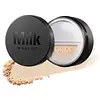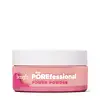Milk Makeup Pore Eclipse Matte Translucent Setting Powder Versus Benefit Cosmetics The Porefessional Power Powder
What's inside
What's inside
 Key Ingredients
Key Ingredients

 Benefits
Benefits

 Concerns
Concerns

 Ingredients Side-by-side
Ingredients Side-by-side

Mica
Cosmetic ColorantSilica
AbrasiveLauroyl Lysine
Skin ConditioningMagnesium Myristate
Zea Mays Starch
AbsorbentLens Esculenta Seed Extract
Skin ProtectingBakuchiol
AntimicrobialNiacinamide
SmoothingPersea Gratissima Fruit Extract
EmollientWater
Skin ConditioningCaprylic/Capric Triglyceride
MaskingMaltodextrin
AbsorbentSodium Hyaluronate
HumectantEthylhexylglycerin
Skin ConditioningPhenoxyethanol
PreservativeIron Oxides
CI 77947
CI 77492
Cosmetic ColorantCI 77499
Cosmetic ColorantCI 77007
Cosmetic ColorantMica, Silica, Lauroyl Lysine, Magnesium Myristate, Zea Mays Starch, Lens Esculenta Seed Extract, Bakuchiol, Niacinamide, Persea Gratissima Fruit Extract, Water, Caprylic/Capric Triglyceride, Maltodextrin, Sodium Hyaluronate, Ethylhexylglycerin, Phenoxyethanol, Iron Oxides, CI 77947, CI 77492, CI 77499, CI 77007
Silica
AbrasiveMica
Cosmetic ColorantCetyl Alcohol
EmollientCaprylic/Capric Triglyceride
MaskingMagnesium Carbonate
AbsorbentPentylene Glycol
Skin ConditioningKaolin
AbrasiveGlyceryl Caprylate
EmollientCaprylyl Glycol
EmollientPotassium Sorbate
PreservativeSodium Benzoate
MaskingDehydroacetic Acid
PreservativeGlyceryl Undecylenate
EmollientParfum
MaskingPentaerythrityl Tetra-Di-T-Butyl Hydroxyhydrocinnamate
AntioxidantTocopherol
AntioxidantCI 77491
Cosmetic ColorantCI 77492
Cosmetic ColorantCI 77499
Cosmetic ColorantSilica, Mica, Cetyl Alcohol, Caprylic/Capric Triglyceride, Magnesium Carbonate, Pentylene Glycol, Kaolin, Glyceryl Caprylate, Caprylyl Glycol, Potassium Sorbate, Sodium Benzoate, Dehydroacetic Acid, Glyceryl Undecylenate, Parfum, Pentaerythrityl Tetra-Di-T-Butyl Hydroxyhydrocinnamate, Tocopherol, CI 77491, CI 77492, CI 77499
 Reviews
Reviews

Ingredients Explained
These ingredients are found in both products.
Ingredients higher up in an ingredient list are typically present in a larger amount.
This ingredient is an emollient, solvent, and texture enhancer. It is considered a skin-softener by helping the skin prevent moisture loss.
It helps thicken a product's formula and makes it easier to spread by dissolving clumping compounds.
Caprylic Triglyceride is made by combining glycerin with coconut oil, forming a clear liquid.
While there is an assumption Caprylic Triglyceride can clog pores due to it being derived from coconut oil, there is no research supporting this.
Learn more about Caprylic/Capric TriglycerideCi 77492 is also hydrated iron III oxide. It's sole purpose is to give a yellow hue to products.
Iron III oxides are classified as inorganic chemicals for coloring.
Synthetically created Ci 77492 is considered safer than those naturally found. This is because the synthetically created version may contain less impurities. Iron oxides are generally non-toxic and non-allergenic.
Learn more about CI 77492Ci 77499 is also hydrated iron III oxide. It is created from mixing red and black iron oxides. This helps give shades of darkness to a product.
Iron III oxides are classified as inorganic chemicals for coloring.
Mica is a naturally occurring mineral used to add shimmer and color in cosmetics. It can also help improve the texture of a product or give it an opaque, white/silver color.
Serecite is the name for very fine but ragged grains of mica.
This ingredient is often coated with metal oxides like titanium dioxide. Trace amounts of heavy metals may be found in mica, but these metals are not harmful in our personal products.
Mica has been used since prehistoric times throughout the world. Ancient Egyptian, Indian, Greek, Roman, Aztec, and Chinese civilizations have used mica.
Learn more about MicaSilica, also known as silicon dioxide, is a naturally occurring mineral. It is used as a fine, spherical, and porous powder in cosmetics.
Though it has exfoliant properties, the function of silica varies depending on the product.
The unique structure of silica enhances the spreadability and adds smoothness, making it a great texture enhancer.
It is also used as an active carrier, emulsifier, and mattifier due to its ability to absorb excess oil.
In some products, tiny microneedles called spicules are made from silica or hydrolyzed sponge. When you rub them in, they lightly polish away dead skin layers and enhance the penetration of active ingredients.
Learn more about Silica